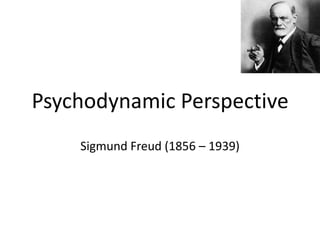
Freud
- 1. Psychodynamic Perspective Sigmund Freud (1856 – 1939)
- 2. Aims and Objectives Aim: To introduce the Psychodynamic Approach and Freud’s theories By the end of the lesson you should be able to: • Describe the main assumptions of the psychodynamic approach to psychology • Describe the three parts of the mind as proposed by Freud
- 3. Sigmund Freud (1856 – 1939) • Born into a Jewish family • After fleeing Nazism as he rejected Anti-Semitism (prejudice against or hatred of Jews), he eventually died in London of mouth cancer. • In the 1930’s the government arranged a book burning to burn the works of Freud and others as they were considered to have degenerate views
- 4. Freud’s Main Concepts • Model of the mind/psyche • Structure of Personality • Psychosexual Stages of Child Development • Defence Mechanisms • Psychoanalysis (Treatment of abnormality)
- 6. Psychoanalytic Theory’s Key Assumptions The key assumption of the psychodynamic approach is that all human behaviour is driven by unconscious motives that we often have no awareness or knowledge of Childhood is a critical period in development of our behaviour and personality Our behaviour is a result of an interaction between unconscious innate drives (i.e. desire of pleasure) and early experiences (extent to which our early desires were gratified) Personality differences can be traced back to the way the early conflicts between desire and experience were handled. These conflicts remain with the adult and exert pressure through unconsciously motivated behaviour.
- 7. Model of the Mind/Psyche
- 8. Freud’s Structure of Personality • Personality consists of three main parts: 1. Id 2. Ego 3. Superego • Called Iceberg Analogy
- 9. The Id • Primary driving force is sexual instinct, which operates in the unconscious • Operates using the pleasure principle – wants things immediately!
- 10. The Ego • This is the conscious, rational mind and it develops during the first two years of life. • It works on the reality principle • Balances the needs of the Id and Superego
- 11. The Superego • This is the moral component of personality • Developed from societal and parental standards of what is appropriate behaviour • Develops at Age 5
- 14. Learning objectives • To learn about Freud's theory of dreaming. • To investigate how dreams reveal powerful unconscious thoughts.